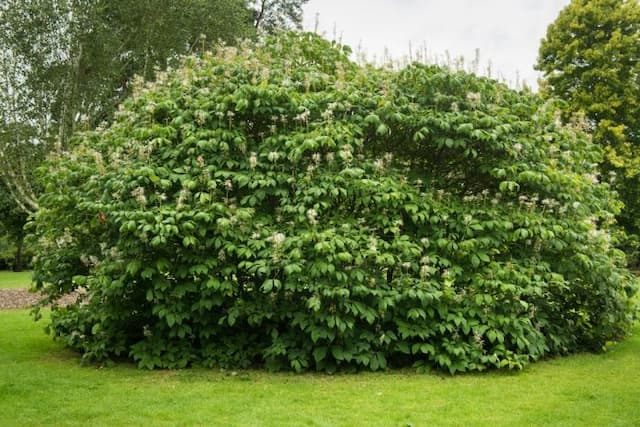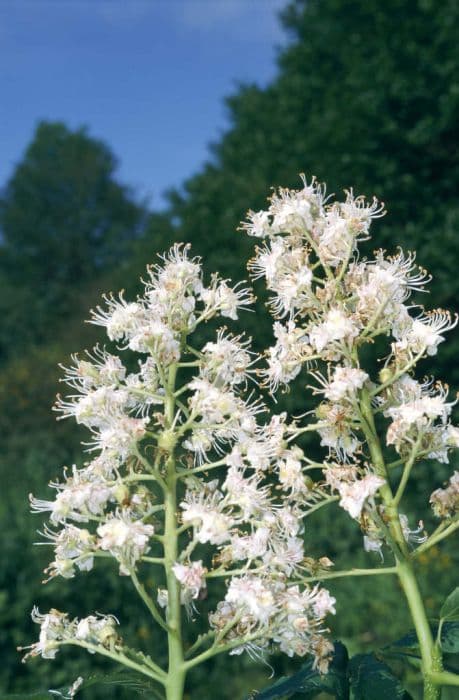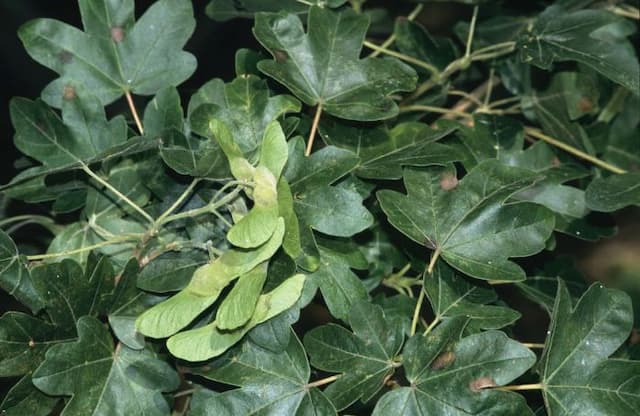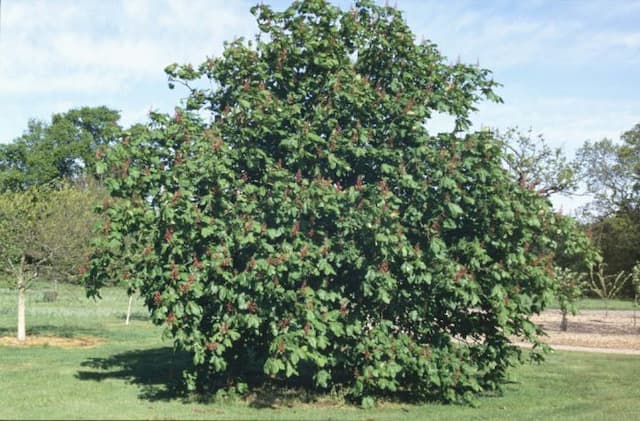Goldenrain tree Koelreuteria paniculata

ABOUT
The plant commonly known as the Golden Rain Tree is a deciduous tree that is highly ornamental and widely appreciated for its aesthetic qualities. It is often recognized by its compound leaves which are green in color and change to yellow in the fall, providing a display of autumnal color. Each leaf is made up of multiple leaflets that create a feather-like appearance. In the summer, the Golden Rain Tree is adorned with panicles of bright yellow flowers that bloom prolifically. These flowers are small yet numerous, creating a striking contrast against the green foliage. After the flowering period, the tree produces distinctive, lantern-like seed pods. The pods are initially green or pinkish-green and eventually dry to a light brown color. They are papery in texture and can hang on the tree well into the winter months. The bark of the Golden Rain Tree is also a notable feature. It has a rough texture and is typically grayish-brown. The overall shape of the tree can vary but often is rounded or spreading, giving it a welcoming presence in the landscape. The tree is favored in various settings for its shade, ornamental qualities, and adaptability to urban environments. Its cheerful yellow flowers are the highlight of its ornamental appeal, and the name "Golden Rain Tree" is derived from the appearance of these flowers as they seem to rain down like golden droplets from the sunny canopy.
About this plant
 Names
NamesFamily
Sapindaceae
Synonyms
Golden Rain Tree, Pride of India, China Tree, Varnish Tree
Common names
Koelreuteria apiculata Rehder & E. H. Wilson, Koelreuteria bipinnata Franch., Koelreuteria chinensis (Murray) Hoffmanns., Koelreuteria elegans subsp. formosana (Hayata) F. G. Mey., Koelreuteria paniculata var. apiculata (Rehder & E. H. Wilson) Rehder, Koelreuteria paniculata var. lixianensis T. Chen, Koelreuteria paniculata var. pubescens T. Chen, Sapindus chinensis Murray.
 Toxicity
ToxicityTo humans
The Golden Rain Tree (Koelreuteria paniculata) is generally considered not toxic to humans. There are no significant symptoms of poisoning associated with this tree, and ingestion of parts of this tree, such as leaves, flowers, or seeds, typically does not lead to any serious consequences. However, it is always advisable to avoid eating parts of ornamental plants due to the potential for idiosyncratic reactions or the presence of pesticides.
To pets
The Golden Rain Tree is not commonly listed as toxic to pets. There should not be severe symptoms of poisoning in pets if they ingest parts of this tree, such as leaves or seeds. However, individual pets might still experience mild gastrointestinal upset if they consume plant matter that they are not used to. As a general precaution, it is wise to prevent pets from eating non-food plants to avoid any potential issues.
 Characteristics
CharacteristicsLife cycle
Perennials
Foliage type
Deciduous
Color of leaves
Green
Flower color
Yellow
Height
30 feet [9 meters]
Spread
35 feet [10.7 meters]
Plant type
Tree
Hardiness zones
5
Native area
China,Korea
Benefits
 General Benefits
General Benefits- Ornamental Value: The Golden Rain Tree is prized for its striking yellow flowers that bloom in summer, adding color and beauty to landscaped settings.
- Shade Provider: With its broad canopy, it creates a pleasant shade which is beneficial in urban and garden environments.
- Urban Tolerance: The tree is adaptable to various urban conditions such as pollution and soil compaction, making it a versatile choice for city plantings.
- Drought Resistance: It has the ability to withstand periods of drought once mature, reducing the need for irrigation and maintenance.
- Wildlife Attraction: The flowers, seeds, and structure of the tree provide habitat and food for a variety of wildlife including birds and pollinators.
- Fall Foliage: The Golden Rain Tree offers visual interest in the fall with leaves that change color to shades of yellow, orange, and red.
- Rapid Growth: This species is known for its fast growth rate, allowing it to quickly establish and provide benefits in a landscape setting.
- Erosion Control: With its extensive root system, it can help stabilize the soil and prevent erosion.
 Medical Properties
Medical Properties- Anti-inflammatory: Koelreuteria paniculata may contain compounds that help reduce inflammation.
- Antioxidant: The plant is believed to have antioxidant properties that could help in protecting the body from oxidative stress.
- Hepatoprotective: There are indications that the plant might offer some protection to the liver from certain types of damage.
- Antimicrobial: Some components within Koelreuteria paniculata might have the ability to inhibit the growth of bacteria or other microorganisms.
 Air-purifying Qualities
Air-purifying QualitiesThis plant is not specifically known for air purifying qualities.
 Other Uses
Other Uses- Koelreuteria paniculata, commonly known as the Golden Rain Tree, can be used as a dye plant, as its flowers yield a yellow dye that can be used for textiles.
- The wood of the Golden Rain Tree is medium to hard and can be used in fine woodworking, joinery, or for making small wooden objects such as boxes or decorative items.
- The seeds of the plant are sometimes used in traditional jewelry making, especially in China where they may be incorporated into rosaries or necklaces.
- Due to its natural resistance to pests and diseases, the Golden Rain Tree is often used as a rootstock for grafting other less hardy species in horticulture.
- The tree's canopy provides excellent shade, making it ideal for use in urban landscaping and park developments to create cool, shaded areas.
- In some cultures, the thin, papery seed pods are used in crafts for making ornaments or decorative items due to their unique texture and appearance.
- The Golden Rain Tree's striking appearance when in bloom is utilized for ornamental purposes in bonsai culture, adding an exotic appeal to miniature landscapes.
- The dense foliage of the Golden Rain Tree makes it suitable for use as a windbreak or natural barrier, helping to protect more vulnerable plants or structures from harsh winds.
- Because of its fast growth and ability to thrive in urban conditions, the Golden Rain Tree is often planted to quickly provide greenery to new housing developments or reforestation areas.
- The bright yellow autumn leaves provide an important source of color in landscape design, used to contrast with evergreens or complement autumnal themes.
Interesting Facts
 Feng Shui
Feng ShuiThe Golden Rain Tree is not used in Feng Shui practice.
 Zodiac Sign Compitability
Zodiac Sign CompitabilityThe Golden Rain Tree is not used in astrology practice.
 Plant Symbolism
Plant Symbolism- Celebration: Koelreuteria paniculata, commonly known as Golden Rain Tree, is often associated with joy and celebration due to its bright, eye-catching yellow flowers that resemble falling rain or fireworks when in bloom.
- Wealth and Good Fortune: The Golden Rain Tree is believed to bring prosperity and good luck, largely in part to its golden colored flowers that are reminiscent of gold and wealth.
- Summer and Vitality: Its full bloom in the summer season stands as a symbol of vitality, energy, and the exuberance of life because of its vibrant and lively appearance during this time.
- Beauty and Elegance: With its graceful form and beautiful flowers and foliage, the Golden Rain Tree serves as a symbol of beauty and elegance in the landscape.
 Water
WaterThe Golden Rain Tree requires moderate watering, especially during dry spells. Generally, it should be watered deeply once a week, providing about 1.5 to 2 gallons of water per session. The amount may need to increase during periods of extreme heat or drought. During the winter, its water requirements decrease, and watering can be done less frequently. Always check the soil moisture content before watering; the top few inches should dry out between waterings.
 Light
LightThe Golden Rain Tree thrives best in full sun conditions. It should be planted in a spot that receives at least six hours of direct sunlight daily to ensure its growth and bloom potential are maximized. Partial shade is tolerable, but flowering may be less abundant.
 Temperature
TemperatureThe Golden Rain Tree can tolerate a wide range of temperatures, but it grows best when the temperature range is between 60 and 90 degrees Fahrenheit. It can survive minimum winter temperatures down to about -10 degrees Fahrenheit, making it suitable for many temperate climates.
 Pruning
PruningThe Golden Rain Tree should be pruned to maintain its shape and remove any dead or broken branches. Pruning is best done in the late winter or early spring before new growth starts. Light pruning can also be done after the tree has flowered to shape it or control its size.
 Cleaning
CleaningAs needed
 Soil
SoilThe Golden Rain Tree thrives in well-draining soil with a pH range of 5.5 to 7.5. The ideal soil mix should consist of loamy soil enriched with organic compost to ensure nutrients and proper drainage. For optimal growth, it is suggested to mix garden soil, sand, and compost in equal parts, making a rich, fertile substrate that maintains moisture without becoming waterlogged.
 Repotting
RepottingThe Golden Rain Tree is a large, deciduous tree and typically does not require repotting as it is planted directly in the ground. It's usually transplanted as a young tree and does not need to be moved frequently, if at all, once established. Trees grown in containers for specific reasons will need repotting every 2-3 years or when they outgrow their current pot.
 Humidity & Misting
Humidity & MistingThe Golden Rain Tree is tolerant of a wide range of humidity conditions and thrives best in ambient outdoor humidity. It does not require any specific humidity adjustments when planted in its preferred outdoor environment.
 Suitable locations
Suitable locationsIndoor
Not ideal for indoors due to size; use bright light and large space.
Outdoor
Plant in full sun, well-draining soil, and water regularly.
Hardiness zone
5-9 USDA
 Life cycle
Life cycleKoelreuteria paniculata, commonly known as the golden rain tree, begins its life cycle as a seed that germinates in spring. The seedling grows rapidly and can establish as a young tree within a few months, with the distinctive compound leaves unfurling as it matures. Within a few years, the tree reaches juvenility and starts to flower in summer, producing large panicles of yellow flowers followed by distinctive lantern-like seed pods. The seeds within these pods require a period of cold stratification to successfully germinate. After flowering, the tree enters a period of vegetative growth where it increases in height and canopy spread, eventually reaching up to 30 feet tall at maturity. K. paniculata completes its life cycle when it eventually ages and declines in vigor, with individual trees living up to 50 years or more under optimal conditions.
 Propogation
PropogationPropogation time
Spring-Early Summer
The Golden Rain Tree, Koelreuteria paniculata, is primarily propagated through seed. The best time for this is in the fall, directly after the seeds have matured and been harvested. To propagate, seeds should be sown in a well-draining soil mix, covered lightly with soil, and kept moist until germination occurs. As they have a hard outer seed coat, it can be beneficial to scarify the seeds beforehand by gently rubbing them with sandpaper or nicking them with a knife to encourage water absorption and germination. The seeds typically germinate within a few weeks to a few months, after which the seedlings can be transplanted to their final growing location once they have developed a strong root system and are large enough to handle.









